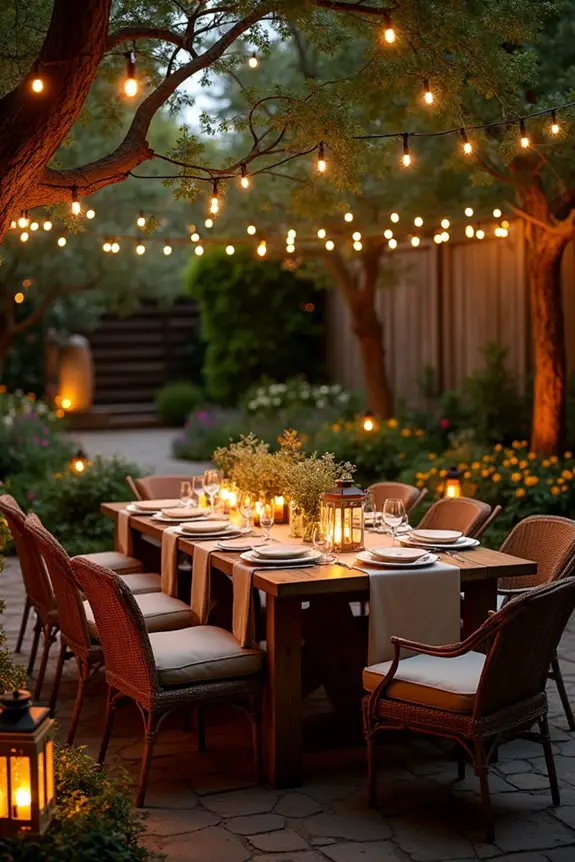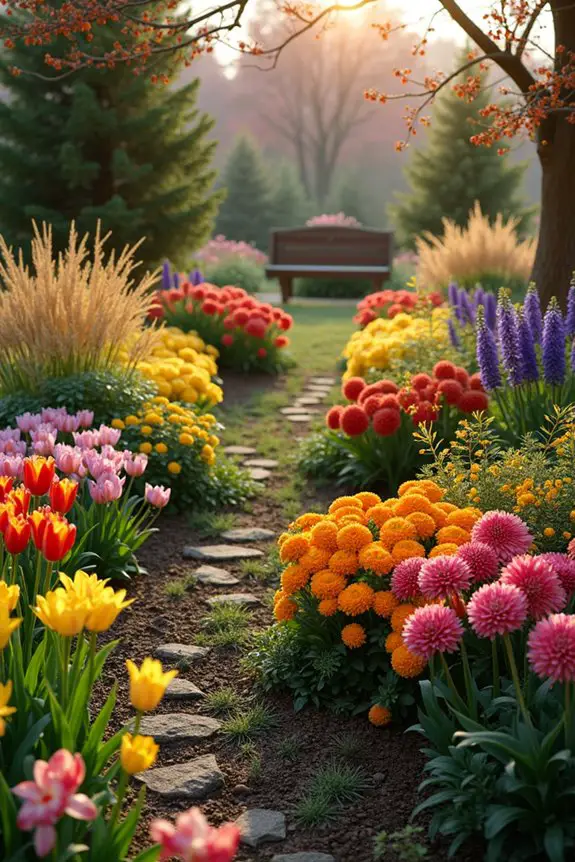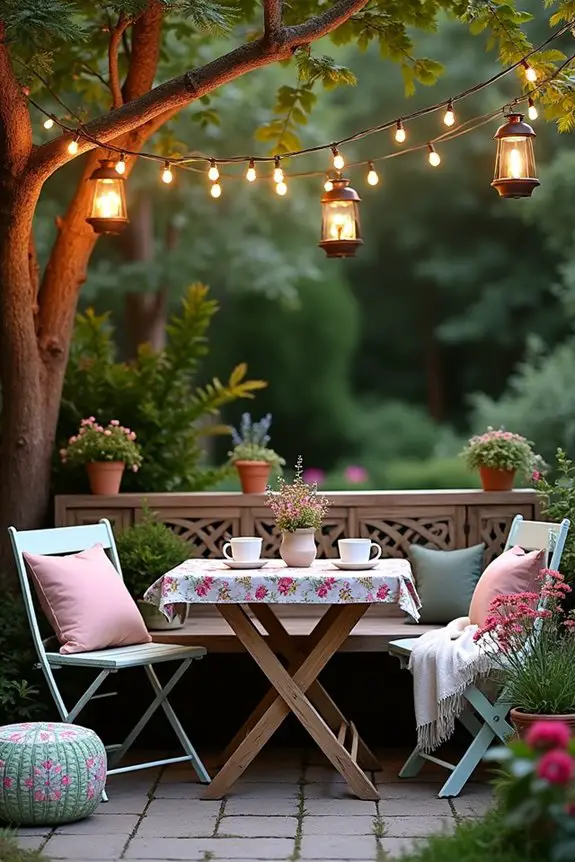Did you know that your garden can actually help reduce stress and boost your mood? It’s true. With the right design, it can become your personal sanctuary. Whether you’re envisioning a sleek Zen garden or a charming cottage-style retreat, the possibilities are endless. So, how do you get started on transforming that empty patch into something amazing? Let’s explore some design ideas that’ll make your garden not just beautiful, but functional and eco-friendly too.
The Layouts for Garden Spaces
When you think about your garden layout, imagine it as a canvas waiting for your touch.
Whether you’re drawn to the tranquility of a Zen-inspired design, the whimsy of a cottage-style space, or the practicality of vertical gardens, each choice tells a story.
So, what vibe are you aiming for?
Let’s explore some layouts that can make your outdoor area truly shine.
1. Zen-Inspired Garden Design
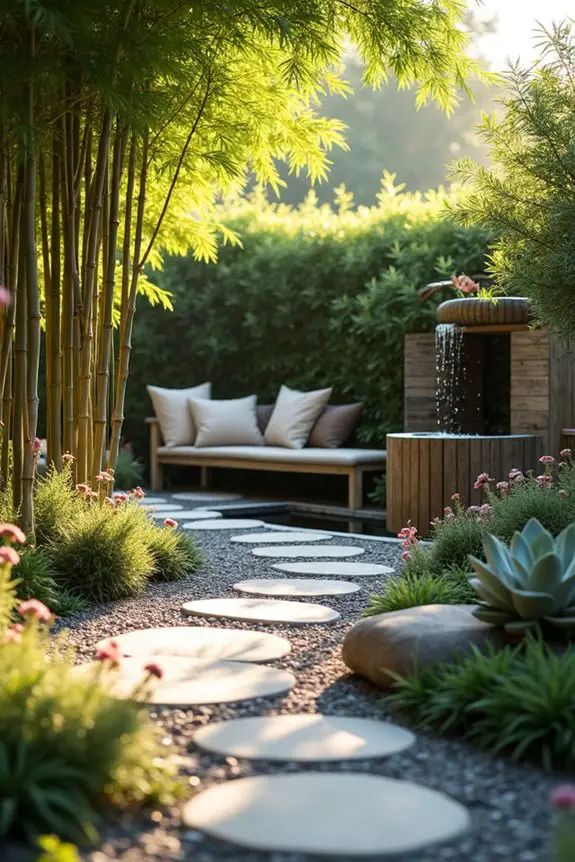
Creating a Zen-Inspired Garden is like setting the stage for a peaceful retreat right in your backyard. It’s all about crafting spaces that breathe serenity and inspire reflection. The best part? It serves a dual purpose—functionality and tranquility. Imagine stepping outside your door to a calming oasis, where every element invites relaxation.
First up, think about your layout. A winding path is a must. Picture a gentle, meandering trail made of smooth stones or soft wood chips, beckoning you to explore. It creates a sense of journey, drawing you in and encouraging leisurely strolls. You know, the kind where you can lose yourself in thought or just soak up the surroundings. Incorporating long handled pruning loppers can help keep your pathways clear of overgrown foliage, ensuring that your meandering trail is always inviting.
Add in a little greenery, perhaps some bamboo or low-maintenance succulents. They don’t just look good; they thrive with little fuss—just like my attempts at gardening, which often results in a glorious mix of thriving weeds and plant therapy for my casualties.
Next, consider excluding loud noises or distractions. That means, yes, a water feature! A simple bamboo fountain is perfect; it seems to whisper rather than shout. The gentle trickle of water works as a meditation soundtrack. Incorporating a waterfall garden feature elevates the serenity, creating a beautiful focal point in your Zen retreat.
Picture yourself seated nearby, sipping your favorite drink, while your worries float away like leaves on a stream. Or, let’s be real, you might end up splashing more than sipping—happens to the best of us, right?
Lastly, don’t forget seating! Cozy spots, like a low wooden bench or a simple meditation cushion, invite you to pause. Whether it’s reading a book, enjoying a cup of tea, or practicing mindfulness, these little spaces encourage you to take a breather from the chaos of life.
It’s all about creating a retreat that’s uniquely you, without the need for an away trip. And who knows, maybe you’ll even find your inner Zen—or at least a good excuse to avoid that mountain of laundry.
2. Sustainable Garden Design Elements
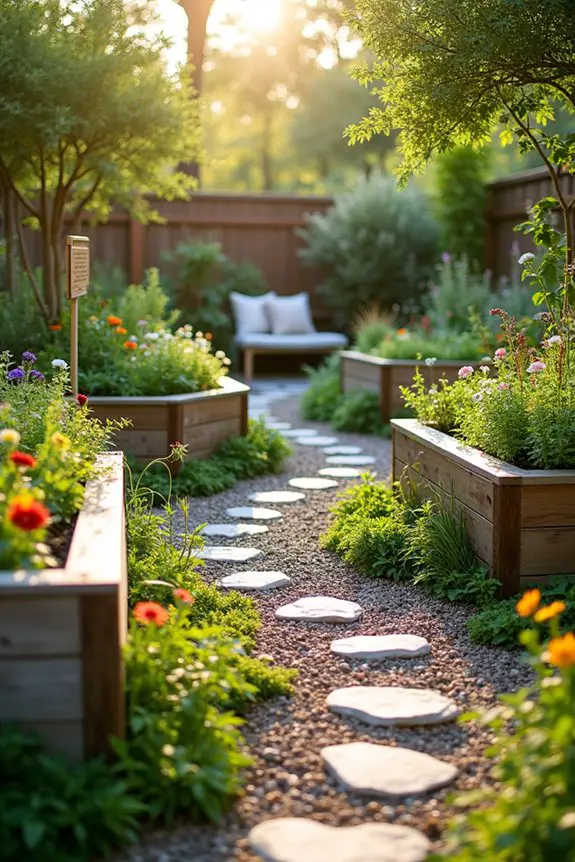
When it comes to sustainable garden design, getting the layout just right is key. Not only does it make your outdoor space functional, but it also creates a harmonious vibe that feels good. Consider eco-friendly choices that give back to the earth while offering a serene escape for you and the critters of the garden.
Start with raised beds or container gardens. These nifty little gems aren’t just for veggies; they can hold flowers, herbs, or whatever your green thumb desires. The best part? They keep your plants off the ground, which can help with drainage and reduce weed growth. Plus, they’re easier on the back—trust me, bending over can be a workout I didn’t sign up for.
Arrange them in a way that creates flow, maybe in a gentle curve or staggered fashion that encourages exploration.
Next, don’t forget about paths. Curved paths using permeable materials like gravel or stepping stones work wonders. Not only do they look beautiful, but they also help with water drainage. Envision this: you’re walking down a winding path, surrounded by fragrant blooms, and suddenly, the stresses of the day melt away.
Add a few native plants along the paths, and you’ll attract pollinators without any extra effort—talk about teamwork!
Including a composting area is also a brilliant idea. Not only does it provide nutrient-rich soil for your garden, but it’s also a great way to recycle kitchen scraps. Just imagine all those old coffee grounds and veggie peels transforming into black gold for your plants.
Your garden will flourish, and you get to feel like an eco-warrior—all while saving on mulch.
Lastly, think about what you want your garden to be. A peaceful space? A gathering place? Just remember, structure and sustainability can go hand in hand. Every time you step outside, take a moment to appreciate your little slice of nature—it’s yours, after all.
And who knows, maybe even the weeds will take a hint and find a new hobby.
3. Water Feature Garden Design
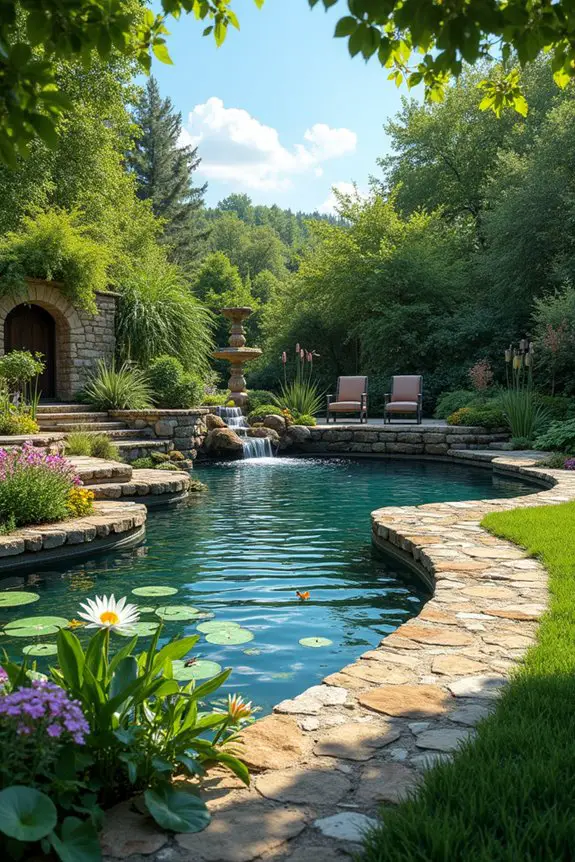
Water features can be a fabulous addition to your garden. Not only do they provide a soothing soundtrack of trickling water, but they also attract wildlife and create a beautiful focal point. Envision sitting in your garden, listening to the gentle splash while sipping your morning coffee—it’s like nature’s own soundtrack.
First off, think about the size and type of water feature that suits your space. A small pond or a fountain can add a magical touch without overwhelming a tiny yard. If you have more space, a larger pond with a waterfall can create a stunning statement. And yes, those Pinterest-worthy waterfalls are achievable—just remember to grab your rubber boots, because suddenly you’re an aspiring landscape designer. Including a heated garden hose can also simplify your maintenance routine during colder seasons.
Next, consider the placement. You’ll want your water feature to be easily visible from your favorite seating spots. If you enjoy watching birds or butterflies, putting it near your blooming plants will draw in visitors. Picture this scenario: you’re lounging on a cozy chair, and all around you, nature is putting on a show. Sounds idyllic, right?
Now let’s talk about maintenance. It might sound intimidating, but truly, once it’s set up, it’s like a pet you only need to feed occasionally. Invest in a good pump and a filtration system to keep the water clear and healthy. Additionally, a beautiful water feature can enhance your overall garden aesthetics, bringing both form and function to your outdoor oasis.
And don’t forget to add some aquatic plants—these little guys can help maintain water quality while giving your feature that natural look. Trust me, they bring a lively energy that can turn any dull area into a lively aquarium-like paradise.
Lastly, enjoy the process. Designing a water feature can feel overwhelming at times, but immerse yourself (figuratively, of course). Embrace your creativity, laugh off the small mistakes, and enjoy watching how your garden transforms into that tranquil retreat you’ve always envisioned.
Just remember, it’s your space—make it a reflection of you, and don’t sweat the small stuff.
4. Cottage-Style Garden Design
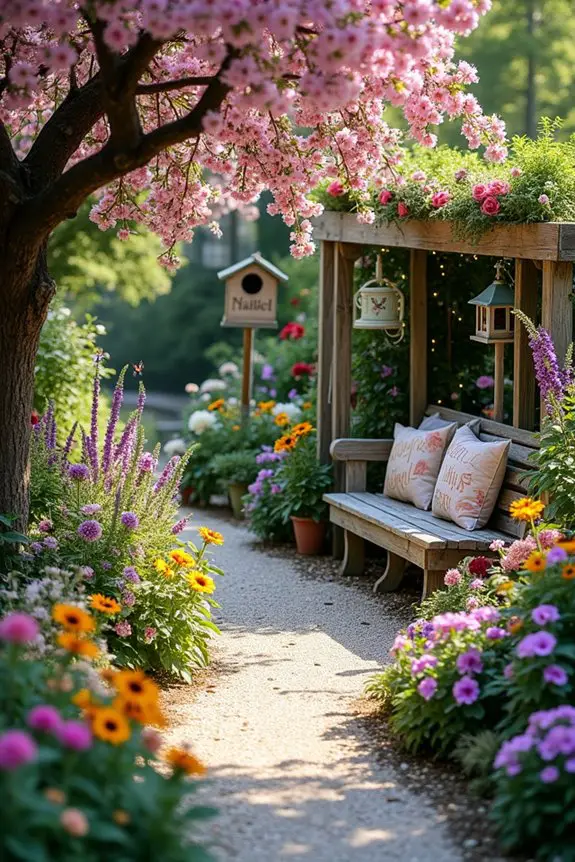
When you think of a cottage-style garden, imagine a whimsical retreat filled with charm and character. This idea works because, not only does it bring a cozy, inviting atmosphere, but it also maximizes space beautifully. In a cottage-style garden, you can intertwine beauty and functionality, creating a space that feels like a storybook come to life.
Start with a winding path made of natural stone or gravel. It leads you through a delightful maze of flowers, herbs, and perhaps even a few fun garden ornaments. If you have a small area, don’t fret—curved paths can make even the tiniest garden feel expansive, giving it that secret garden vibe. Picture you strolling down that path, flowers brushing against your knees, and a gentle breeze rustling the leaves. Magical, isn’t it?
Next, think about layering. This style loves a good height difference—short plants at the front and taller blooms at the back. This way, everything gets the spotlight and keeps the garden from feeling flat. You want to create a tapestry of colors and textures. Use climbing plants on trellises, and hang a few pots with flowers like petunias or ivy. It’s like an art piece that evolves with the seasons.
Now, let’s chat about seating. A little bench tucked under the shade of a blooming tree can be your personal oasis or reading nook. It calls for lazy afternoons or tea at sunset, and you’ll want to dress it up with cushions and maybe a throw for that extra touch of coziness. As you sip your favorite drink there, you’ll feel like you’ve stepped into your own private retreat where worries melt away into the petals swirling around you.
Don’t forget the personal touches, like quirky garden signs or fairy lights strung across your entryway. These elements make your garden not just a collection of plants but an extension of who you are. Add your favorite plant identifiers, maybe with a dash of humor—”Garden of Weedin'” could be a fun one. It reflects your personality and gives passersby a chuckle while they admire your green thumb.
Lastly, embrace the natural chaos that comes with gardening. Too many plants may seem overwhelming, but the beauty lies in balance and variety. If something doesn’t thrive, just yank it out and try something new—it’s like being a superhero of your own tiny ecosystem. You might also consider incorporating effective pest control measures like yellow insect sticky traps to protect your flourishing garden.
5. Vertical Garden Design
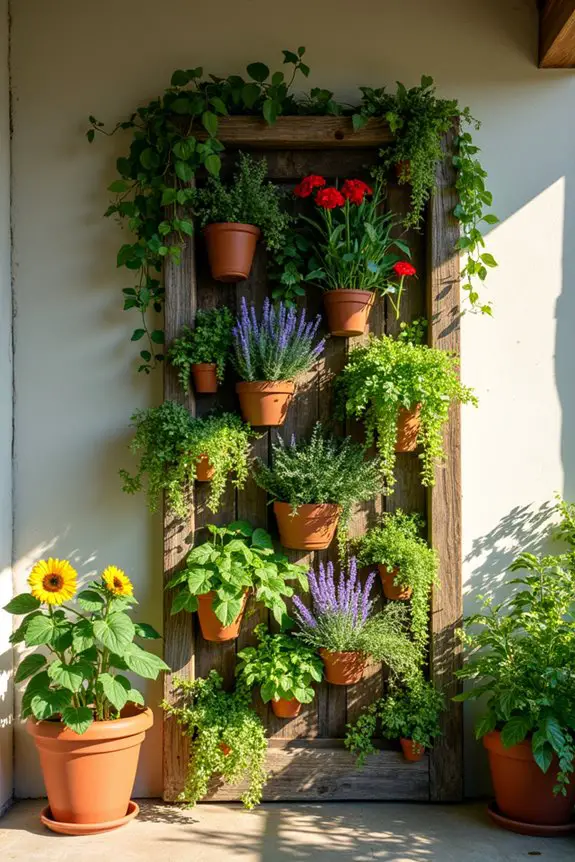
When space is tight or you just want to add an extra layer of visual interest, vertical gardening is a fabulous way to go. This idea works like a charm because it saves precious ground space while creating an eye-catching display. Think about it: vertical gardens can transform boring walls into lush green masterpieces, adding life and personality to your outdoor (or indoor) area.
To start, consider the wall or structure you want to use. You can repurpose an old pallet, build a wooden frame, or even hang fabric planters. Just imagine those vibrant vines cascading down, or herbs sprouting in neat little pockets. It’s like bringing a piece of nature right up to your eyes—or perhaps even nose, depending on what you plant. A little creativity goes a long way.
Next, think about your plant selection. This is where the fun really begins. Opt for trailing plants like ivy or string-of-hearts to drape gracefully. You might also want to throw in some colorful flowers or fragrant herbs. I recommend mixing textures and colors to create a feast for the eyes.
Just picture the beauty of lavender and mint mingling with bright red geraniums. How delightful!
When setting it up, be mindful about spacing. It’s important to pack in enough plants, but too many can lead to a jungle situation—you don’t want to forget a plant is even there. Each plant needs enough room to breathe (and grow), so keep that in mind.
And, let’s be honest, nobody wants to grapple with a plant-induced game of hide-and-seek in their garden.
Now let’s talk maintenance. A vertical garden can seem intimidating, but once you get into the groove, it’s rather simple. Regular watering is key—consider drip irrigation if you really want to make life easier. Trust me, you don’t want to find yourself making an emergency dash with a watering can every other day.
And remember, there will be some trial and error. Plants may not always respond as you hope, and that’s perfectly okay. Just chuckle at the ones that didn’t make it into the spotlight and learn for next time.
Gardening is about growth—both plants and skills—so don’t sweat the small stuff.
6. Modern Minimalist Garden Design
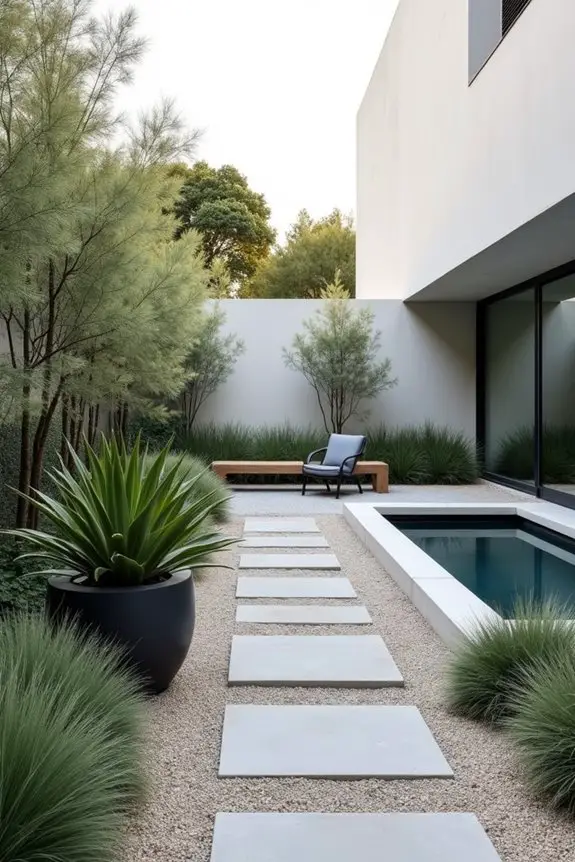
When it comes to creating a modern minimalist garden, the beauty lies in simplicity. This design approach embraces clean lines, geometric shapes, and a limited plant palette, which leads to a serene and uncluttered environment. It’s functional, yet stylish—a great way to showcase your space without overwhelming it.
Start by envisioning the layout of your garden space. Think about the essential components: pathways, seating areas, and maybe even a focal point like a sleek sculpture or a minimalist water feature. You want elements that speak to you while offering practicality. For example, a simple stone walkway can guide guests through your outdoor oasis, providing both function and visual interest.
Now, let’s talk plant selection. In a minimalist garden, less is often more. Choose a few well-placed plants that stand out. Consider using architectural plants like succulents or ornamental grasses; they offer striking silhouettes without the fuss.
Pairing a single large potted plant with smaller ground covers can draw the eye and create balance. You’re aiming for that “wow” factor, showcasing each plant without overcrowding the space.
One of the best parts? Maintenance is a breeze. With fewer plants comes less watering, less pruning, and less of that frantic search for your gardening gloves. Seriously, your garden can look stunning without the chaotic upkeep. Set a schedule for keeping things tidy, and you’ll be zen in no time.
Finally, don’t forget the little details. Using outdoor furniture that reflects the minimalist vibe, like a simple wooden bench or sleek metal chairs, can tie everything together beautifully. Just picture yourself sipping coffee, surrounded by a clean aesthetic that speaks to your soul.
7. Botanical Theme Garden Design
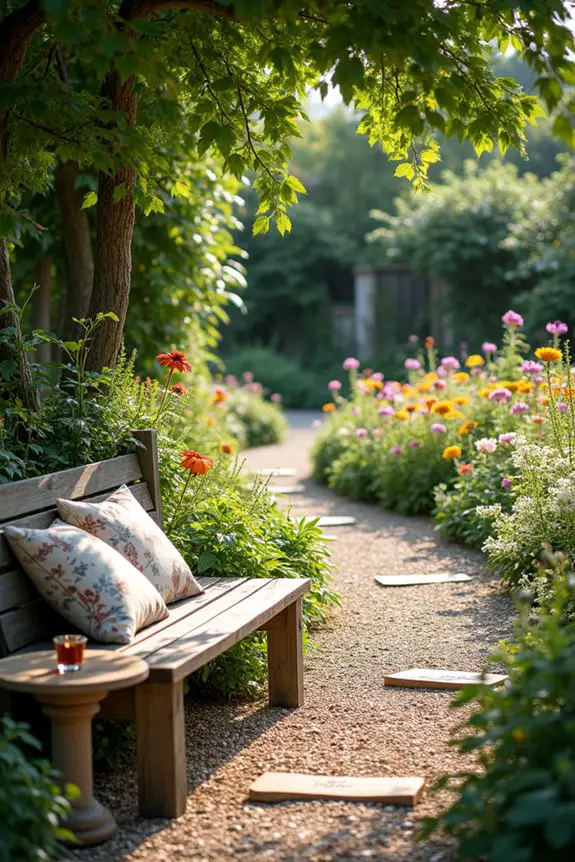
When you think about creating a botanical-themed garden, imagine stepping into a living, breathing gallery of plants. This design works beautifully because it combines an artistic flair with the practicality of cultivating your very own green haven. Think of it as bringing the vibe of a botanical conservatory right into your backyard, making it a space to relax, explore, and learn.
So, let’s plunge into layouts. First, sketch out a plan that showcases a variety of plant species. Mixing different heights, colors, and textures is key. How about starting with a circular bed in the center? This creates an inviting focal point—a true botanical feature that draws you in. Line the circle with taller plants, like sunflowers or hollyhocks, then shift into medium-sized plants like daisies or echinacea for that harmonious flow.
Don’t forget to incorporate a winding path that allows for leisurely strolls, encouraging exploration. With each bend, plant clusters reveal new surprises—maybe a fragrant herb garden, or a small patch of exotic flowers. It’s like a treasure hunt for your senses.
Speaking of treasures, consider adding labels to your plants. Not only does it boost your botanical knowledge, but you might just impress your friends with your newfound expertise.
And let’s think about seating. A rustic bench or a couple of cozy chairs can invite you to sit down and really soak in the beauty surrounding you. You’ll find that a relaxed area helps you connect with nature and can inspire even the most novice gardener.
Just imagine yourself sipping iced tea, surrounded by blooms that practically shout “Look at me!”
In the end, a botanical theme garden isn’t just a visual feast—it’s a chance to nurture your love for plants while creating a tranquil retreat. With just a bit of planning and creativity, you’ll have a garden that feels alive and invigorating. So, are you ready to dig in?
8. Desert Oasis Garden Design
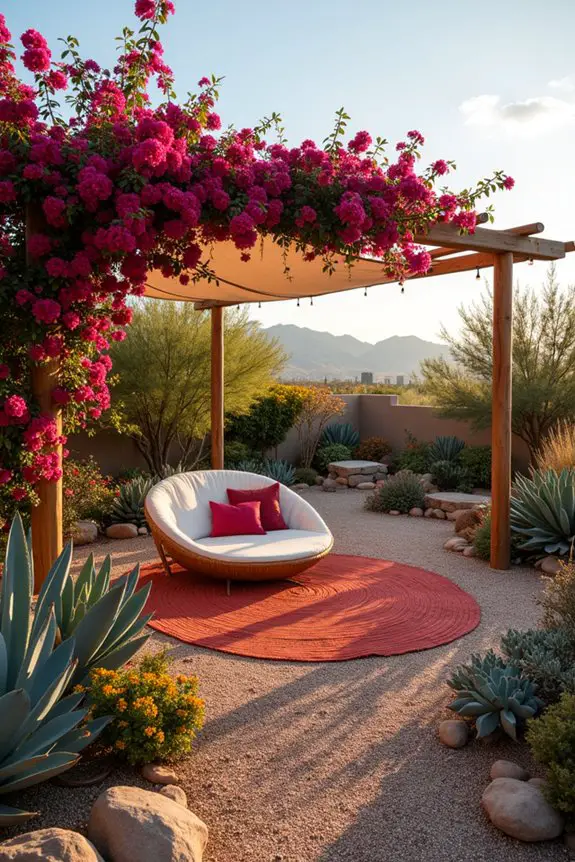
Creating a desert oasis garden design is like bringing a slice of the arid beauty of the Southwest right to your backyard. This idea works because it marries functionality with a serene vibe that allows you to feel both relaxed and invigorated, even on the driest of days. It’s a space that celebrates resilience, yet beckons you to unwind in its sheltering embrace.
To start off, consider laying out your garden in distinct zones, each with its own purpose and feel. Think about a central lounging area surrounded by an array of drought-tolerant plants like succulents, cacti, and native wildflowers. You can go for a crescent moon shape for that soft, inviting feel, which wraps around seating that invites you to sit back and take it all in. Picture yourself sprawled out on a colorful rug, sipping some lemonade, surrounded by furry little agave plants that look like they’re ready for a party.
Now, let’s talk about pathways. A winding gravel or decomposed granite trail enhances the natural essence of your oasis. Imagine the crunch beneath your feet as you wander through, maybe with a friend or two. Every twist reveals another gem—like a carefully placed rustic bench or a cluster of vibrant desert blooms.
Speaking of surprises, consider integrating a small water feature or a birdbath to create a soothing sound and attract birds, which adds a delightful splash of life.
And don’t forget about the art of shade. Incorporating structures like a pergola or shade sails not only creates relief from the sun but also serves as an anchor for climbing plants like bougainvillea or jasmine, adding color and fragrance. You can almost hear your friends asking, “How did you get it to look so effortlessly beautiful?” Well, you can smile and say it’s all about blending the right elements with a little love.
Lastly, lighting is key. Using low-voltage string lights or lanterns can create a magical ambiance come sunset. Picture those twinkling lights dancing through the leaves, casting gentle glows on your company as you all share laughs and stories under the stars. Just be prepared for the inevitable “Wow, can we stay here forever?” moments.
Ultimately, a desert oasis garden is more than just a collection of plants; it’s a harmonious retreat that balances beauty and sustainability. With careful planning, a sprinkle of creativity, and maybe a few hiccups along the way (like planning that one-too-many succulents), you can craft a space that feels revitalizing and inviting.
Are you ready to dig into this adventure? Let’s make it happen.
9. Sensory Garden Design Elements
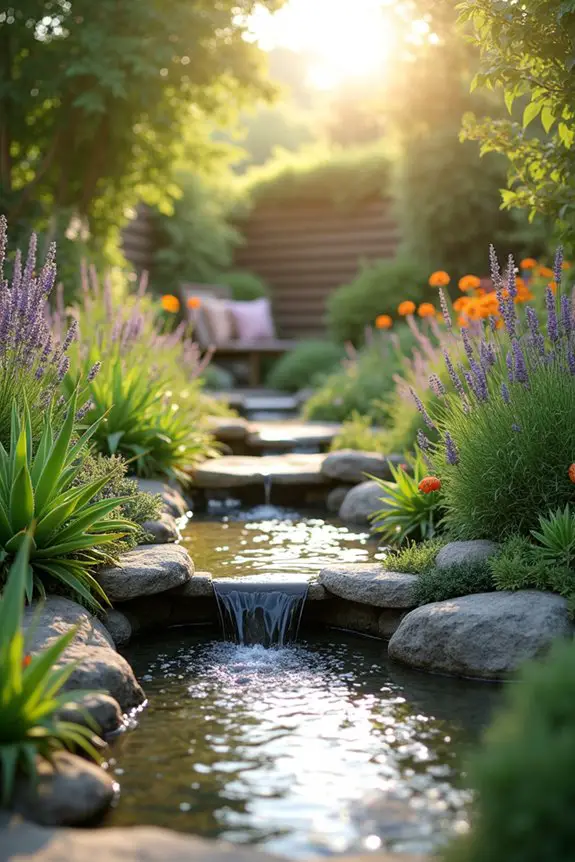
Creating a sensory garden is like crafting a feast for your senses—each element contributes to an experience that’s not only functional but also rich in ambiance and style. Imagine stepping into a space that engages your sight, sound, smell, touch, and even taste. It’s about more than just pretty plants; it transforms your garden into a personal retreat that tickles your senses and invites exploration.
Let’s plunge into the layout ideas for a sensory garden. Start with the sound element—think about installing a gentle water feature, like a small fountain or a babbling brook. The soothing sound of water can drown out the hustle and bustle of life. Picture yourself sitting nearby, feeling the worries of the day melt away. You might even catch yourself humming along to nature’s rhythm. Don’t you just love it when the world feels a bit quieter?
Next up is the smell. Consider planting fragrant herbs like lavender or rosemary along your pathways. Oh, the joy of brushing against those plants and catching a whiff of their delightful scent! You’ll want to plant them close enough that the aroma reaches the seating area, creating a fragrant hug that welcomes guests. Plus, if you’re feeling adventurous in the kitchen, you can snip some fresh herbs for your next culinary creation—talk about a win-win!
For touch, add varied textures with a selection of plants. Try combining the smooth leaves of hostas with the rough texture of succulents. You might even create little touch stations where your guests can run their fingers through soft grasses or the fuzzy leaves of lamb’s ear. It’s like a tiny tactile adventure, and trust me, you’ll have your friends giggling as they discover their new favorite plant to pet.
Oh, and let’s not forget about taste! Why not include a little herb or veggie patch? Imagine walking through your garden, and right there, you pluck a cherry tomato to snack on or grab a fresh basil leaf to chew on. It adds an interactive element that your friends will love, even if they may raise an eyebrow at your snack choices.
Finally, consider the layout’s flow. Create meandering pathways that guide visitors from one sensory station to another—each stop can be a new delight. It’s like a treasure hunt but with plants. And if you’re anything like me, those paths will surely be conquered: even if you trip over your own feet a few times in the pursuit of the perfect selfie with the latest bloom.
In a nutshell, a sensory garden is more than just a collection of pretty plants; it’s an experience that invites you and your visitors to engage with nature on multiple levels. It’s about creating joy in the little things, with touches of fun and whimsy along the way. So roll up your sleeves and prepare for a garden adventure that’s sure to bring smiles and memories. Who knows, maybe this will be the spot where you tell your friends, “You’ve got to try this herb—it’s delicious!”
10. Garden Lighting Design Ideas
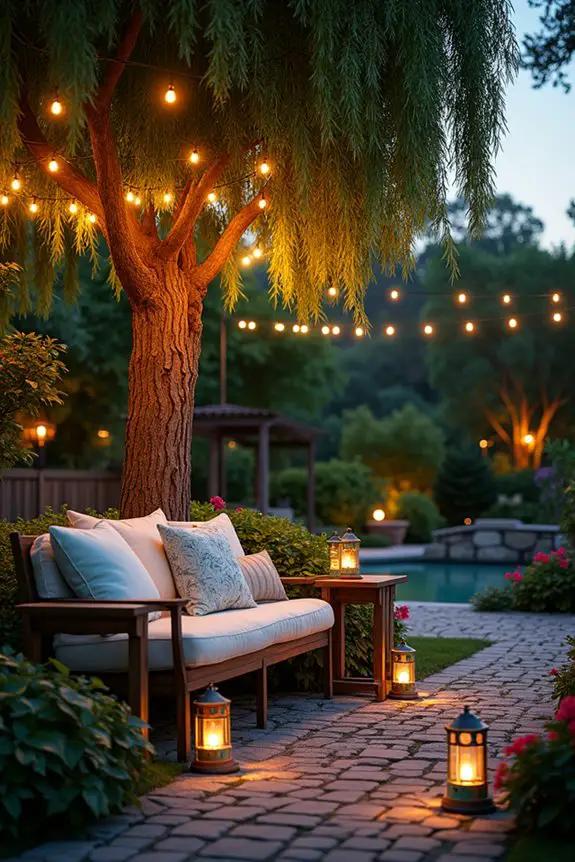
When it comes to gardening, there’s a whole new world that comes alive as the sun sets—a world that’s just waiting for you to discover, especially with the right lighting. Visualize your garden transformed into a magical wonderland, where shadows dance and soft glows highlight your favorite plants. Plus, good lighting not only sets the mood—think cozy evenings sipping tea or lively barbeques with friends—but it also keeps areas safe and accessible after dark.
So, let’s delve into some fun garden lighting ideas that will brighten up your outdoor space and make it feel like an extension of your home.
First off, string lights are a total game-changer. Envision this: you hang warm, twinkling fairy lights from tree branches or across fences, creating a whimsical canopy under which to gather. They’re perfect for romantic dinners or just lounging with a book, and they can turn any ordinary evening into something special.
Just picture twinkling lights reflecting off a nearby pond or glimmering against a backdrop of vibrant flowers. That right there will have your neighbors peeking over the fence, trying to catch a glimpse of the enchantment.
Next up, solar lights are super convenient and eco-friendly. These little gems charge during the day and turn on automatically at night. You can line your pathways with them for a soft guiding glow or dot them around your garden beds to showcase your plants.
It’s like giving each flower a personal spotlight. Plus, you won’t have to worry about finding an outlet or changing batteries—just place them where the sun can shine, and you’re golden.
Now, let’s talk about spotlights. If you want to really highlight a favorite tree or a stunning sculpture, adjustable spotlights are the way to go. You can angle them just right to draw the eye without being too harsh.
It’s all about showcasing your best features, sort of like how we tilt our head to get the perfect selfie. Trust me, your garden deserves its moment in the spotlight.
Don’t forget about lanterns—those timeless beauties that add a touch of charm anywhere. You can hang them from hooks, set them on tabletops, or even tuck them into nooks around your garden.
You can use candles, string lights inside, or even battery-operated ones for a worry-free glow. There’s something about the flickering light that makes everything feel a little less ordinary, right?
Just be careful; I once tripped over an extension cord while trying to look graceful, and I can assure you, that’s a story no one wants to be part of.
Lastly, if you have a cozy seating area, consider using uplighting to create a warm and inviting ambiance. Placing lights at the base of chairs or furniture can create a soft glow that makes the space feel extra inviting.
It’s all about setting the stage for good conversation and maybe even a few ghost stories. Plus, you’ll be able to show off your garden and also keep those pesky mosquito bites at bay (or at least try to).
Maintenance Schedule Suggestions
While a garden may look stunning on the surface, keeping it vibrant requires a solid maintenance schedule. You don’t want your new build garden ideas to wilt away, right?
Start by watering plants early in the morning or late in the evening; trust me, your plants will thank you. Weekly, check for weeds—those pesky guys love to invade. And don’t forget about pruning! Snipping those overgrown branches will keep everything looking sharp.
Monthly, plan for a fertilization boost; it’s like giving your garden a little energy drink. Oh, and seasonal cleanups? Essential for keeping debris at bay. Think of it as tidying up after a party—necessary and so rewarding.

